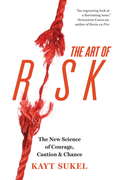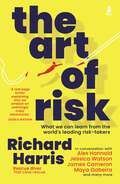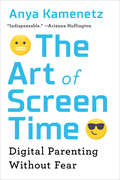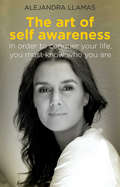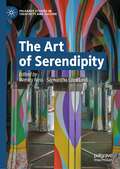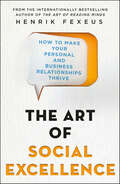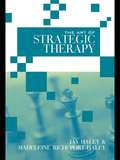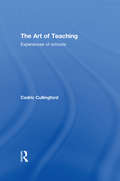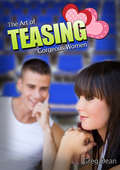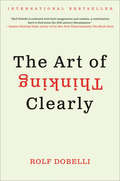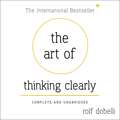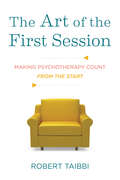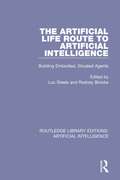- Table View
- List View
The Art of Relational Supervision: Clinical Implications of the Use of Self in Group Supervision
by Helena HargadenThe Art of Relational Supervision demonstrates the clinical implications of the relational approach when applied to supervision. Describing her philosophical and theoretical rationale for setting up relational supervision groups, Helena Hargaden’s goal in supervision is to reveal the relational unconscious within the client/therapist relationship. Here, with chapters from members of these groups, the vitality of supervision is brought to life as the clinical implications of the therapist's internal world are highlighted by group members. The complexity of group dynamics are explored and psychotherapists show how this positively affects their work with clients and patients. The main themes examined in the book are the: Bi-directionality of the relational unconscious Ubiquity of therapeutic enactments and ruptures Intuitive use of improvisation Co-creation of the intersubjective third – the analytic third Focus on mutuality and reciprocity Filled with case study examples, readers of The Art of Relational Supervision will gain a deep insight into the complex dynamics which form an integral part of any supervision and discover how, this type of relational approach strengthens the therapeutic relationship to bring about significant psychological change for the client. It will be an invaluable resource for psychotherapists, counsellors and psychologists.
The Art of Risk
by Kayt SukelAre risk-takers born or made? Why are some more willing to go out on a limb (so to speak) than others? How do we weigh the value of opportunities large or small that may have the potential to change the course of our lives? These are just a few of the questions that author Kayt Sukel tackles, applying the latest research in neuroscience and psychology to compelling real-world situations. Building on a portfolio of work that has appeared in such publications as Scientific American, Atlantic Monthly, The Washington Post, and more, Sukel offers an in-depth look at risk-taking and its role in the many facets of life that resonates on a personal level. Smart, progressive, and truly enlightening, The Art of Risk blends riveting case studies and hard-hitting science to explore risk-taking and how it impacts decision-making in work, play, love, and life, providing insight in understanding individual behavior and furthering personal success.From the Hardcover edition.
The Art of Risk
by Richard HarrisDiving doctor on the Thai Cave Rescue (now a Netflix series) and former joint Australian of the Year explores the stories of other people who regularly risk their lives and what we can learn from their expertise. Are free-solo climbers, underwater cave explorers and big-wave surfers crazy ... or cautious? How do soldiers and fighter pilots manage risk? What can we learn from how BASE jumpers and drag racers prepare that we can take into our own lives? &‘Harry&’ Harris – Thai Cave Rescuer, joint Australian of the Year – has an unusual idea of fun: he crawls though pitch-black, confined caves, deep underground and usually underwater. To most, that&’s a nightmare. To him, it&’s recreation. He&’s prepared for all conceivable risks, he&’s completely focused. And the discipline and danger involved leave him better prepared for everyday life. In this ultimate armchair adventure, Harry takes us into the lives of other &‘risk-takers&’, to find out why they do what they do. We meet people adventuring from the highest skies to the deepest oceans – BASE jumpers, drag racers, snipers and surfers – including climber Alex Honnold (from the movie Free Solo), sailor Jessica Watson, film director and deep-sea diver James Cameron. Each gripping story is a masterclass in risk from the experts: when to go, when to say no, how to prepare and above all, how pushing ourselves a little further helps us become more courageous and resilient in all of our challenges.Heart-pounding and eye-opening, you&’ll never look at risk the same way again. &‘Richard &“Harry&” Harris peels back the mindset that shapes the line between recklessness and courage.&’ Hugh Riminton
The Art of Screen Time: How Your Family Can Balance Digital Media and Real Life
by Anya Kamenetz<P>Finally, an evidence-based, don't-panic guide to what to do about kids and screens. <P>Today's babies often make their debut on social media with the very first sonogram. They begin interacting with screens at around four months old. But is this good news or bad news? A wonderful opportunity to connect around the world? Or the first step in creating a generation of addled screen zombies? <P>Many have been quick to declare this the dawn of a neurological and emotional crisis, but solid science on the subject is surprisingly hard to come by. In The Art of Screen Time, Anya Kamenetz--an expert on education and technology, as well as a mother of two young children--takes a refreshingly practical look at the subject. Surveying hundreds of fellow parents on their practices and ideas, and cutting through a thicket of inconclusive studies and overblown claims, she hones a simple message, a riff on Michael Pollan's well-known "food rules": Enjoy Screens. Not too much. Mostly with others. <P>This brief but powerful dictum forms the backbone of a philosophy that will help parents moderate technology in their children's lives, curb their own anxiety, and create room for a happy, healthy family life with and without screens.
The Art of Self Awareness
by Alejandra LlamasIf you're ready to break repetitive patterns, if you want to have a rich, deep and authentic life experience, this book is for you. The book you have in your hands is the way to understand who you really are and the wide spectrum of possibilities that await in your life story.Enter into a deeper dimension regarding your great purpose as an individual and as part of humanity. Based on ontological coaching and the teachings of ancestral wisdom, this book will lead you to understand that truly, everything is possible."There are books that change lives and this is one of them. Alejandra Llamas has that surprising capacity to find what is important in life and, furthermore, knows how to communicate it. Her message, and the way that she expresses it on radio and television, is simply vital. But, to be honest, you have to start by reading her."Jorge Ramos, journalist and author."Coaching freed me from concepts that trapped my mind and soul. Thanks to personal coaching, I redirected my energy towards the right road, the road that makes you better and happier. To have been led by Alejandra Llamas is the best thing that ever happened to me."Gloria Calzada
The Art of Serendipity (Palgrave Studies in Creativity and Culture)
by Samantha Copeland Wendy RossSerendipity and creativity are both broad, widely disputed, and yet consistently popular concepts which are relevant to understanding the positive aspects of our daily lives and even human progress in the arts and sciences. The chapters in this book reflects a variety of theoretical and practical approaches to serendipity in various domains, including creative problem solving, sculpture, writing, theatre and design. Chapter authors address issues such as the nature of the ‘prepared mind’, the role of accidents, serendipity as a skill or way of engaging with the world and, indeed, how serendipity works as a concept and practice in relation to the dynamic flow of the creative system. Those who wish to explore the nature of chance in art and creativity, as well as in their daily lives, will find much to ponder in these pages.
The Art of Sex Therapy Supervision
by James C. Wadley Richard SiegelThe Art of Sex Therapy Supervision is a collection of scholarly writings and case narratives that sheds light on issues that sex therapists face as supervisors or supervisees and provides techniques that can be adapted to fit clients' specific needs. Written by experts in a range of fields, this book covers a wide range of perspectives and methodologies for assisting diverse populations, including conservative Christians, LGBTQ clients, and those who exhibit out-of-control sexual behavior. It addresses individual, relational, and systemic engagement in the context of sexual function/dysfunction, and it also discusses obstructions clinicians can face when providing critical feedback to clients. This book will be useful for aspiring supervisors as well as those who supervise clinicians seeking licensure or certification.
The Art of Silence and Human Behaviour: Interdisciplinary Perspectives
by Theodor IttenThis book examines the phenomenon of silence in relation to human behaviour from multiple perspectives, drawing on psychological and cultural-philosophical ideas to create new, surprising connections between silence, quiet and rest. Silence and being quiet are present in everyday life and in politics, but why do we talk about it so rarely? Silence can be cathartic and peaceful, but equally oppressive and unbearable. In the form of communication, we keep secrets to protect ourselves and others, but on the other hand subjects can be silenced with dictatorial posturing - a communicative display of power – and something can be literally ‘hushed up’ that needs to be disclosed. In unique and engaging style, Theodor Itten explores the multi-layered internal conversation on silence in relation to the self and emotions, demonstrating why it is sometimes necessary in our modern society. Describing and analyzing human behaviour in relation to silence, the book also draws on psychoanalytic ideas by outlining the power of silence in processing our emotions and relationships and hiding innermost feelings. With rich narrative signposts providing thought-provoking and amusing insights, and interpersonal communication examined in relation to everyday life, this is fascinating reading for students and academics in psychology, philosophy, cultural studies, and related areas.
The Art of Social Excellence: How to Make Your Personal and Business Relationships Thrive
by Henrik FexeusHenrik Fexeus uses his expert psychology knowledge to teach the reader how to hone their social skills, perfect for fans of Dale Carnegie.Research has increasingly shown that nonverbal communication prowess is absolutely essential in seemingly unrelated areas of our lives (investment decisions, salary levels, etc.). However, as our society becomes more modernised and we incorporate new forms of technology into our daily interactions, we are becoming less and less capable of understanding one another as we should.In The Art of Social Excellence, Henrik Fexeus combines his own expert knowledge as a mentalist with psychology studies to create a complete guide to social interaction. He covers it all: from overcoming your conversational fears in a large group of people, to excelling in the workplace, to winning an argument with your partner. He breaks down various rhetorical strategies in detail and provides helpful steps and checklists for the reader to check their progress in a social encounter.Anyone who has ever felt awkward or misunderstood in social situations will benefit from reading this book, and with proper implementation of Fexeus' principles, can achieve superior social skills.
The Art of Social Excellence: How to Make Your Personal and Business Relationships Thrive
by Henrik FexeusIn this follow-up to The Art of Reading Minds, Henrik Fexeus uses his expert psychology knowledge to teach the reader how to hone their social skills, perfect for fans of Dale Carnegie.Research has increasingly shown that nonverbal communication prowess is absolutely essential in seemingly unrelated areas of our lives (investment decisions, salary levels, etc.) However, as our society becomes more modernized and we incorporate new forms of technology into our daily interactions, we are becoming less and less capable of understanding one another as we should. In The Art of Social Excellence, Henrik Fexeus combines his own expert knowledge as a mentalist with psychology studies to create a complete guide to social interaction. He covers it all: from overcoming your conversational fears in a large group of people, to excelling in the workplace, to winning an argument with your partner. He breaks down various rhetorical strategies in detail, and provides helpful steps and checklists for the reader to check their progress in a social encounter. Anyone who has ever felt awkward or misunderstood in social situations will benefit from reading this book, and with proper implementation of Fexeus's principles, can achieve superior social skills.
The Art of Strategic Therapy
by Jay Haley Madeleine Richeport-HaleyExperience the art of Jay Haley's strategic therapy as he personally utilizes a variety of techniques in treating depression, violence, and psychosis with couples, children, families and various ethnic groups.Visit www.haley-therapies.com for additional resources by Jay Haley, including live videos of the pioneering therapist in action.
The Art of Talking So That People Will Listen
by Paul W. SwetsTalking comes naturally...but getting people to listen is an art. This brand-new guide provides you with practical, proven strategies for mastering the art of effective, persuasive communication the--skill most essential to your enjoyment of other people and the achievement of personal success.
The Art of Teaching: Experiences of Schools
by Cedric CullingfordA central dilemma for teachers is finding ways to deal with the multiple perspectives and demands of pupils, parents, school management, and external forces. The Art of Teaching explores the tension between teaching and learning that all teachers face. Presenting a series of insights into the art of teaching from the perspectives of those individuals most closely involved in the schooling process, the book explores pupil voice in schools, and experiences of teaching and learning from the pupil perspective. Providing an opportunity for self reflection, the book also examines teachers’ relationships with parents, external agencies and their attitudes towards pupils. Subjects covered include: What pupils think of teachers Teacher’s views of themselves and self reflection School hierarchies and the ethos of inspection Using pupil insights to inform learning strategies Essential reading for all teachers and students, this book offers a unique insight into school relationships and structures, giving readers an awareness of what is like to be a teacher. Professor Cedric Cullingford’s many books include "The Causes of Exclusion" (Taylor and Francis) and "How Pupils Cope with School" (Cambridge Scholar’s Press).
The Art of Teasing Gorgeous Women
by Greg DeanFinally, a dating advice book that teaches you how to hold your ground when you don't know how to handle the confidence and tests of gorgeous women.Make a gorgeous woman laugh through flirting and teasing and you can capture her heart. This book full of dating advice for men will show you how.Gorgeous women have heard it all before:"You are so beautiful.""You have the most beautiful eyes.""Wow, you have a really sexy body."The compliments bore them when they come from men who are way too easy to obtain.This easy-to-follow guide will teach you:- Sexual confidence- To have a complete lack of neediness- To convey you are popular, fun and very funny, even if you're not- How to handle virtually any conversation with gorgeous women so you appear strong, cocky and awesome to be with.Renowned date coach, Greg Dean gives you the vital blueprint you need to create stunning attraction between you and the gorgeous woman you are falling for.Men love compliments. Women love to be teased and challenged. So if you want to attract beautiful women, you must take another tact.Too many guys play too nice or go way too far. This book teaches you that perfect balance. It will teach you to grow your own style but provides a complete back up system when you need to challenge her on the spot in a fun, friendly, confident way.This guide is an absolute must for any guy who gets nervous around gorgeous women, conveys way too much interest and constantly gets friend zoned, or worse, ignored.If you want the best possible chance to get the gorgeous girl and you don't know how to really handle yourself, this instruction book will show you what to say to her and give you the best possible chance at success.Confident, gorgeous women love to be teased and challenged in a loving, fun way. This is the art of teasing gorgeous women.
The Art of Thinking Clearly
by Rolf DobelliHave you ever . . . Invested time in something that, in hindsight, just wasnt worth it? Paid too much in an eBay auction? Continued to do something you knew was bad for you? Sold stocks too late, or too early? Taken credit for success, but blamed failure on external circumstances? Backed the wrong horse?These are examples of what the author calls cognitive biases, simple errors all of us make in day-to-day thinking. But by knowing what they are and how to identify them, we can avoid them and make better choices: whether in dealing with personal problems or business negotiations, trying to save money or earn profits, or merely working out what we really want in life--and strategizing the best way to get it. Already an international bestseller, The Art of Thinking Clearly distills cutting-edge research from behavioral economics, psychology, and neuroscience into a clever, practical guide for anyone whos ever wanted to be wiser and make better decisions. A novelist, thinker, and entrepreneur, Rolf Dobelli deftly shows that in order to lead happier, more prosperous lives, we dont need extra cunning, new ideas, shiny gadgets, or more frantic hyperactivity--all we need is less irrationality. Simple, clear, and always surprising, this indispensable book will change the way you think and transform your decision making--at work, at home, every day. From why you shouldnt accept a free drink to why you should walk out of a movie you dont like, from why its so hard to predict the future to why you shouldnt watch the news, The Art of Thinking Clearly helps solve the puzzle of human reasoning.
The Art of Thinking Clearly
by Rolf DobelliHave you ever . . . Invested time in something that, in hindsight, just wasn't worth it? Paid too much in an eBay auction? Continued to do something you knew was bad for you? Sold stocks too late, or too early? Taken credit for success, but blamed failure on external circumstances? Backed the wrong horse?These are examples of what the author calls cognitive biases, simple errors all of us make in day-to-day thinking. But by knowing what they are and how to identify them, we can avoid them and make better choices: whether in dealing with personal problems or business negotiations, trying to save money or earn profits, or merely working out what we really want in life--and strategizing the best way to get it.Already an international bestseller, The Art of Thinking Clearly distills cutting-edge research from behavioral economics, psychology, and neuroscience into a clever, practical guide for anyone who's ever wanted to be wiser and make better decisions. A novelist, thinker, and entrepreneur, Rolf Dobelli deftly shows that in order to lead happier, more prosperous lives, we don't need extra cunning, new ideas, shiny gadgets, or more frantic hyperactivity--all we need is less irrationality.Simple, clear, and always surprising, this indispensable book will change the way you think and transform your decision making--at work, at home, every day. From why you shouldn't accept a free drink to why you should walk out of a movie you don't like, from why it's so hard to predict the future to why you shouldn't watch the news, The Art of Thinking Clearly helps solve the puzzle of human reasoning.
The Art of Thinking Clearly: Better Thinking, Better Decisions
by Rolf DobelliTHE SECRET TO PERFECT DECISION-MAKING'This book will change the way you think' Dan Goldstein, London Business SchoolHave you ever... Invested time in something that, with hindsight, just wasn't worth it? Overpaid in an Ebay auction? Continued doing something you knew was bad for you? Backed the wrong horse?THE ART OF THINKING CLEARLY is essential reading for anyone with important decisions to make. It reveals, in 100 short chapters, the most common errors of judgement, and how to avoid them. Simple, clear and always surprising, this indispensable book will change the way you think and transform your decision-making - at work, at home, every day.SUNDAY TIMES BESTSELLER * GUARDIAN BESTSELLER * INTERNATIONAL BESTSELLER
The Art of Thinking Clearly: Better Thinking, Better Decisions
by Rolf DobelliTHE SUNDAY TIMES BESTSELLERTHE TIMES BESTSELLERMAIL ON SUNDAY BESTSELLERGUARDIAN BESTSELLER AMAZON TOP TEN BESTSELLERLIVE MAGAZINE BESTSELLERIRISH TIMES NUMBER 1 BESTSELLERTHE SECRETS OF PERFECT DECISION-MAKINGHave you ever...Invested time in something that, with hindsight, just wasn't worth it?Overpayed in an Ebay auction?Continued doing something you knew was bad for you?Sold stocks too late, or too early?Taken credit for success, but blamed failure on external circumstances?Backed the wrong horse?These are examples of cognitive biases, simple errors we all make in our day-to-day thinking. But by knowing what they are and how to spot them, we can avoid them and make better choices - whether dealing with a personal problem or a business negotiation; trying to save money or make money; working out what we do or don't want in life, and how best to get it.Already an international bestseller, THE ART OF THINKING CLEARLY is essential reading for anyone with important decisions to make. It reveals, in 100 short chapters, the most common errors of judgement, and how to avoid them. Simple, clear and always surprising, this indispensable book will change the way you think and transform your decision-making - at work, at home, every day.(P)2013 Hodder & Stoughton
The Art of Transforming Nightmares: Harness the Creative and Healing Power of Bad Dreams, Sleep Paralysis, and Recurring Nightmares
by Clare R. JohnsonTransform Nightmares into Healing, Creative, Spiritual GiftsThe Art of Transforming Nightmares is a friendly, hands-on guide to help you tap into the immensely rich gifts that bad dreams offer up when we work with them in healing ways. Dr. Clare Johnson, world-leading expert on lucid dreaming, shares her best practical tips for overcoming nightmares and a unique quiz that identifies your personal sleeper-dreamer type so you can fast-track to the transformative techniques that work best for you.With forty-five practices and fifteen tailor-made nightmare solution programs, this guidebook helps you set up your own unique program for transforming your dream life. It shares practical tools to reduce nightmare frequency, manage sleep paralysis, resolve distressing dreams, and release fear. You'll tap into the deep wisdom of your unconscious mind and discover how to transform your night of sleep into a beautiful, healing refuge so that you wake up energized and ready to lead a life of happiness and wonder.
The Art of Winning: Ten Lessons in Leadership, Purpose and Potential
by Dan CarterDan Carter is a widely hailed as one of the most elite and successful professional rugby players in the world.After retiring from a sport he played for 32 years, he set out to inspire the next generation of leaders to create purposeful impact, joining the Oxford Foundry - Oxford University's Entrepreneurial Institute, founded by LinkedIn co-found Reid Hoffman - as its first ever Leader in Practice. Now, in a follow-up to his bestselling 2015 autobiography, he answers timeless questions for aspiring leaders everywhere. Why is the team more important than the individual? How do you navigate the transition from player to leader? How should we respond when confidence is eclipsed by doubt, when circumstances get the better of us, when setbacks derail us? How can we remain humble and grounded when we're winning - and how can we keep on winning, even when a loss may be just around the corner?Full of inspiring personal stories of both victories and setbacks, the greatest rugby sportsman reflects on his career, shares his own secrets of high performance, and reveals the art of exceeding your highest expectations.
The Art of the First Session: Making Psychotherapy Count From the Start
by Robert TaibbiMaking Psychotherapy Count from the Start The average client today only comes to therapy five to eight times, and many only come once, so it is increasingly important, therefore, for therapists to achieve first-session success. Therapeutic skills and sales and marketing savvy are equally important to this task. In the first sixty minutes, clinicians must build trust, communicate what they have to offer, and ensure that the client feels different when they walk out than they did walking in. Short, practical, and applicable to all therapeutic modalities, this book walks readers through all the first-session essentials, including preparation for the first session, action-steps for each stage of the session, techniques for changing the emotional climate, and “closing the deal,” to make sure that clients come back for more. Packed with case examples, vignettes, tools, and techniques, The Art of the First Session prepares clinicians with critical skills to cut through performance anxiety, feel and convey confidence with clients, and hit the ground running in therapy with new clients.
The Art of the Interesting: What We Miss in Our Pursuit of the Good Life and How to Cultivate It
by Lorraine BesserPhilosopher and popular Middlebury professor Dr. Lorraine Besser reveals the missing third piece in our search for the Good Life—what she calls The Interesting—and teaches us how to cultivate it in our lives. Do you know anyone who's truly living The Good Life? Traditionally, philosophers and psychologists have thought of the Good Life in terms of happiness or meaning, or some combination of both. But, if it&’s really that simple, if all you need is more happiness or meaning to get to the Good Life, why aren&’t more of us achieving that truly &“good&” life? You&’ve hit all the traditional markers, jumped on the happiness train, committed to a gratitude practice, sought purpose in your work, and yet The Good Life you&’re seeking, is still out of reach. Emerging research is revealing that there is, in fact, more to the good life than the current —and even ancient—conversation suggests. This has been identified as psychological richness. Dr. Lorraine Besser, a founding investigator in these studies, shows how psychological richness helps to make our Good Lives more interesting. Interesting experiences captivate our minds, engage our thoughts and emotions, and often change our perspective. What&’s interesting is different for everyone, and everyone can obtain and strengthen the skills necessary to access the interesting. In this illuminating book, you&’ll take a deeper dive into the ways that you can cultivate the interesting in your everyday life, including: How to develop an interesting mindset How to harness the power of novelty How to turn obstacles into adventures Through delightful stories, powerful tools, and new mindsets, you&’ll learn how to &“keep it interesting.&” Whether you feel like something is missing from your life, or you&’re yearning for more, Besser's groundbreaking manifesto will guide you toward a fuller, more satisfying life.
The Art of the Psychotherapist (A Norton Professional Book)
by James BugentalUnlike the brief, specific-solution oriented therapies that many people demand today, the goal of depth therapy is life change. James Bugental has been practicing, teaching and writing about depth therapy for 40 years, and in this book, he shares his experiences as a psychotherapist.
The Artful Species: Aesthetics, Art, And Evolution
by Stephen DaviesThe Artful Species explores the idea that our aesthetic responses and art behaviors are connected to our evolved human nature. Our humanoid forerunners displayed aesthetic sensibilities hundreds of thousands of years ago and the art standing of prehistoric cave paintings is virtually uncontested. In Part One, Stephen Davies analyses the key concepts of the aesthetic, art, and evolution, and explores how they might be related. He considers a range of issues, including whether animals have aesthetic tastes and whether art is not only universal but cross-culturally comprehensible. Part Two examines the many aesthetic interests humans take in animals and how these reflect our biological interests, and the idea that our environmental and landscape preferences are rooted in the experiences of our distant ancestors. In considering the controversial subject of human beauty, evolutionary psychologists have traditionally focused on female physical attractiveness in the context of mate selection, but Davies presents a broader view which decouples human beauty from mate choice and explains why it goes more with social performance and self-presentation. Part Three asks if the arts, together or singly, are biological adaptations, incidental byproducts of nonart adaptations, or so removed from biology that they rate as purely cultural technologies. Davies does not conclusively support any one of the many positions considered here, but argues that there are grounds, nevertheless, for seeing art as part of human nature. Art serves as a powerful and complex signal of human fitness, and so cannot be incidental to biology. Indeed, aesthetic responses and art behaviors are the touchstones of our humanity.
The Artificial Life Route to Artificial Intelligence: Building Embodied, Situated Agents (Routledge Library Editions: Artificial Intelligence #9)
by Rodney Brooks Luc SteelsOriginally published in 1995, this volume is the direct result of a conference in which a number of leading researchers from the fields of artificial intelligence and biology gathered to examine whether there was any ground to assume that a new AI paradigm was forming itself and what the essential ingredients of this new paradigm were. A great deal of scepsis is justified when researchers, particularly in the cognitive sciences, talk about a new paradigm. Shifts in paradigm mean not only new ideas but also shifts in what constitutes good problems, what counts as a result, the experimental practice to validate results, and the technological tools needed to do research. Due to the complexity of the subject matter, paradigms abound in the cognitive sciences -- connectionism being the most prominent newcomer in the mid-1980s. This workshop group was brought together in order to clarify the common ground, see what had been achieved so far, and examine in which way the research could move further. This volume is a reflection of this important meeting. It contains contributions which were distributed before the workshop but then substantially broadened and revised to reflect the workshop discussions and more recent technical work. Written in polemic form, sometimes criticizing the work done thus far within the new paradigm, this collection includes research program descriptions, technical contributions, and position papers.

